Research on Comprehensive Evaluation and Early Warning of Transmission Lines’ Operation Status Based on Dynamic Cloud Computing
Abstract
:1. Introduction
2. Method for Evaluating ETL Status
2.1. Improved HSA Method of Subjective Hierarchical Analysis
- (1)
- Build a model
- (2)
- Construction of the discrimination matrix
- (3)
- Consistency check
- (4)
- Index weight calculation
2.2. Objective Weight Calculation
- (1)
- The standard deviation of each indicator is calculated to reflect the varying extent of each indicator, as shown in Equation (5):
- (2)
- The correlation coefficient of each indicator is calculated, and the correlation quantification equation is obtained.
- (3)
- The amount of information for each indicator is comprehensively calculated, as shown in Equation (6):where represents the information amount of the j-th index, represents the standard deviation, represents the correlation coefficient, and N represents the number of values of the i-th index.
- (4)
- The index weight β is calculated by Equation (7):where represents the objective index weight of the index, represents the information amount of the index, and represents the number of values of the index.
2.3. Subjective and Objective Evaluation
2.4. Calculation of Evaluation Results
3. Weight Analysis of Evaluation Indices Based on Expert Experience
3.1. Calculation of Subjective Weight
- (1)
- Construct regular discriminant matrix and calculate weight
- (2)
- Appraise layer of the discriminant matrix construct and the weight calculation
- (3)
- Overall weight calculation of each indicator of the appraise layer
3.2. Objective Weight Calculation
3.3. Calculation of the Weight
4. Evaluation of Cloud Model Establishment and Verification
4.1. Applicability of the Cloud Model in Early Warning of ETL Operation Status
4.2. Evaluation of the Cloud Model and the Platform’s Establishment
- (1)
- Theory of the cloud
- (2)
- Digital Characteristics of Clouds
- Expectation (Ex): This refers to the expectation of cloud droplet distribution in the universe of discourse, and it is also the core of a cloud, meaning the most probable point of a qualitative concept in the universe of discourse.
- Entropy (En): This measures the randomness of qualitative concepts, which reflects the extent of dispersion of a cloud drop. Furthermore, it reflects the acceptable range of cloud drop values in the universe of discourse. Overall, the value of En directly determines the width of a cloud.
- Super entropy (He): This reflects the uncertainty of entropy, or the entropy of entropy, and its value determines the thickness of a cloud. A high value of He corresponds to high dispersion and viscosity of the cloud.
- (3)
- Clouds computing model platform establishment
- Generate a standard random number En’ with En as the expectation and He as the standard deviation;
- Generate a regular random number xi with Ex as the expectation and En’ as the standard deviation;
- Calculate the cloud titre value using Equation (17):Then, (xi,) is a cloud droplet, which realises the conversion of qualitative concepts into quantitative concepts;
- Repeat steps a–c n times to generate a sufficient number of cloud droplets.
- Input n cloud droplets xi, and calculate the mean value of this group of cloud droplets—that is, the cloud model digital feature expectation Ex and the sample variance S2—using Equations (18) and (19):
- Calculate the digital feature entropy En of the cloud model using Equation (20).
- Calculate the digital feature super entropy (He) of the cloud model using Equation (21).
4.3. Evaluate the Impact of Cloud Model Dynamic Weight
- (1)
- Determine the index and evaluate the cloud
- (2)
- Determining the criteria layer of the dynamic index evaluation cloud
- (3)
- Determine the dynamic, comprehensive evaluation cloud
5. Results and Discussion
5.1. Evaluation Indices’ Dynamic Weight Determination Based on Expert Experience
5.2. Analysis of Sensitive Influencing Factors of Some Key Evaluation Indices, including Data Timeliness
5.3. Determining the Dynamic Combination Weight of Transmission Lines’ Operating Condition Evaluation Index
6. Conclusions
Author Contributions
Funding
Institutional Review Board Statement
Informed Consent Statement
Data Availability Statement
Conflicts of Interest
References
- Danish Standards Foundation (DS). Power Line Communication Apparatus and Systems Used in Low-Voltage Installations in the Frequency Range 1.6 MHz to 30 MHz—Part 1: General. Available online: https://standards.globalspec.com/std/1032332/DS/CLC/TR%2050412-1 (accessed on 21 December 2022).
- Chinese Standard. DL/T 1688-2017_English: PDF (DL/T1688-2017). Available online: https://www.chinesestandard.net/PDF/English.aspx/DLT1688-2017 (accessed on 21 December 2022).
- European Standard. Overhead Electrical Lines Exceeding AC 1 kV—Part 2–4: National Normative Aspects (NNA) for GERMANY (based on EN 50341-1:2012). Available online: https://www.en-standard.eu/csn-en-50341-2-4-overhead-electrical-lines-exceeding-ac-1-kv-part-2-4-national-normative-aspects-nna-for-germany-based-on-en-50341-1-2012-3 (accessed on 21 December 2022).
- International Electrotechnical Committee. Insulators for Overhead Lines—Composite line Post Insulators for A.C. Systems with a Nominal Voltage Greater Than 1 000 V—Definitions, Test Methods and Acceptance Criteria. Available online: https://infostore.saiglobal.com/en-gb/standards/iec-61952-2008-569430_saig_iec_iec_1300548 (accessed on 21 December 2022).
- Lin, C.C.; Yang, C.H.; Shyua, J.Z. A comparison of innovation policy in the smart grid industry across the pacific: China and the USA. Energy Policy 2013, 57, 119–132. [Google Scholar] [CrossRef]
- Wan, J.; Chen, J. AHP based relay selection strategy for Energy Harvesting Wireless Sensor Networks. Future Gener. Comput. Syst. 2022, 128, 36–44. [Google Scholar] [CrossRef]
- Junqueira, A.M.; Andrade, M.R.; Mendes, T.S.; Simoes, S.J. Landslide susceptibility mapping for transmission lines: Dynamic monitoring, analysis and alerts for extreme natural events. Environ. Earth Sci. 2020, 79, 46. [Google Scholar] [CrossRef]
- Malhotra, P.K. Risk-Based Design of Transmission Lines for Hurricane Winds. Struct. Eng. Int. 2014, 24, 275–280. [Google Scholar] [CrossRef]
- Shafaei, A.; Gholami, A.; Shariatinasab, R. Probabilistic evaluation of lightning performance of overhead transmission lines, considering non-vertical strokes. Sci. Iran. 2012, 19, 812–819. [Google Scholar] [CrossRef] [Green Version]
- Yao, M.; Yang, J.J.; Bin Lou, Z. Assessment of ETL Icing State Based on Multi-Sensor Information Fusion. Appl. Mech. Mater. 2014, 687, 3141–3144. [Google Scholar] [CrossRef]
- Ray, P.; Mishra, D.P. Support vector machine based fault classification and location of a long transmission line. Eng. Sci. Technol. Int. J. 2016, 19, 1368–1380. [Google Scholar] [CrossRef] [Green Version]
- Liu, Y.; Xv, J.; Yuan, H.; Lv, J.; Ma, Z. Health assessment and prediction of overhead line based on health index. IEEE Trans. Ind. Electron. 2018, 66, 5546–5557. [Google Scholar] [CrossRef]
- Zhang, W.Q.; Xi, Z.L. Application of Delphi method in screening of indexes for measuring soil pollution value evaluation. Environ. Sci. Pollut. Res. 2021, 28, 6561–6571. [Google Scholar] [CrossRef] [PubMed]
- Zhao, H.; Guo, S. Risk evaluation on UHV power transmission construction project based on AHP and FCE method. Math. Probl. Eng. 2014, 2014, 687568. [Google Scholar] [CrossRef]
- Li, H.Z.; Guo, S. External economies evaluation of wind power engineering project based on analytic hierarchy process and matter-element extension model. Math. Probl. Eng. 2013, 2013, 848901. [Google Scholar] [CrossRef] [Green Version]
- Wang, L. The fault causes of overhead lines in distribution network. In MATEC Web of Conferences; EDP Sciences: Les Ulis, France, 2016; Volume 61, p. 02017. [Google Scholar] [CrossRef] [Green Version]
- Xu, K.; Ding, X.Y.; Chen, H.W.; Jiang, Q.Y.; Sun, K.; Zheng, C.M. Multi-attribute comprehensive evaluation method for power transmission and transformation projects. In Applied Mechanics and Materials; Trans Tech Publications Ltd.: Stafa-Zurich, Switzerland, 2014; Volume 521, pp. 245–251. [Google Scholar] [CrossRef]
- Schaefer, J.L.; Siluk, J.C.M.; de Carvalho, P.S. An MCDM-based approach to evaluate the performance objectives for strategic management and development of Energy Cloud. J. Clean. Prod. 2021, 320, 128853. [Google Scholar] [CrossRef]
- Allahvirdizadeh, Y.; Moghaddam, M.P.; Shayanfar, H. A survey on cloud computing in energy management of the smart grids. Int. Trans. Electr. Energy Syst. 2019, 29, e12094. [Google Scholar] [CrossRef]
- Li, S.; Gu, X.; Zhou, G.; Li, Y. Optimisation and comprehensive evaluation of alternative energising paths for power system restoration. IET Gener. Transm. Distrib. 2019, 13, 1923–1932. [Google Scholar] [CrossRef] [Green Version]
- Li, J.; Xu, W.; Feng, X.; Lu, H.; Qiao, B.; Gu, W.; Zhang, G.; Jiao, Y. Comprehensive evaluation system for optimal configuration of multi-energy systems. Energy Build. 2021, 252, 111367. [Google Scholar] [CrossRef]
- Chen, W.; Hao, X. An optimal combination weights method considering both subjective and objective weight information in power quality evaluation. In Advanced Electrical and Electronics Engineering; Springer: Berlin/Heidelberg, Germany, 2011; pp. 97–105. [Google Scholar] [CrossRef]
- Mokarram, M.; Mokarram, M.J.; Khosravi, M.R.; Saber, A.; Rahideh, A. Determination of the optimal location for constructing solar photovoltaic farms based on multi-criteria decision system and Dempster–Shafer theory. Sci. Rep. 2020, 10, 8200. [Google Scholar] [CrossRef] [PubMed]
- Suh, J.; Brownson, J.R. Solar farm suitability using geographic information system fuzzy sets and analytic hierarchy processes: Case study of Ulleung Island, Korea. Energies 2016, 9, 648. [Google Scholar] [CrossRef]
- Günen, M.A. Determination of the suitable sites for constructing solar photovoltaic (PV) power plants in Kayseri, Turkey using GIS-based ranking and AHP methods. Environ. Sci. Pollut. Res. 2021, 28, 57232–57247. [Google Scholar] [CrossRef]
- Madavan, R.; Saroja, S. Decision making on the state of transformers based on insulation condition using AHP and TOPSIS methods. IET Sci. Meas. Technol. 2020, 14, 137–145. [Google Scholar] [CrossRef]
- Fan, J.; Li, D.; Li, R. Evaluation of MAV/UAV collaborative combat capability based on network structure. Int. J. Aerosp. Eng. 2018, 2018, 5301752. [Google Scholar] [CrossRef] [Green Version]
- Vaidya, O.S.; Kumar, S. Analytic hierarchy process: An overview of applications. Eur. J. Oper. Res. 2006, 169, 1–29. [Google Scholar] [CrossRef]
- Liu, W.; Cheng, R.; Xu, Y.; Liu, Z. Fast reliability evaluation method for composite power system based on the improved EDA and double cross linked list. IET Gener. Transm. Distrib. 2017, 11, 3835–3842. [Google Scholar] [CrossRef]
- Geng, L.; Zhao, Y.; Chen, G. Simplified sequential simulation of bulk power system reliability via chronological probability model of load supplying capability. IEEE Trans. Power Syst. 2017, 33, 2349–2358. [Google Scholar] [CrossRef]
- Wang, J.; Huang, M.; Guo, J. Rock burst evaluation using the CRITIC algorithm-based cloud model. Front. Phys. 2021, 8, 593701. [Google Scholar] [CrossRef]
- Chen, C.; ShanXiong, C.; Chen, L.; YuChen, Z. Method for solving LASSO problem based on multidimensional weight. Adv. Artif. Intell. 2017, 2017, 1736389. [Google Scholar] [CrossRef] [Green Version]
- Lin, Z.; Shi, Y.; Chen, B.; Liu, S.; Ge, Y.; Ma, J.; Yang, L.; Lin, Z. Early warning method for power supply service quality based on three-way decision theory and LSTM neural network. Energy Rep. 2022, 8, 537–543. [Google Scholar] [CrossRef]
- Sun, X.; Lei, Y. Research on financial early warning of mining listed companies based on BP neural network model. Resour. Policy 2021, 73, 102223. [Google Scholar] [CrossRef]
- Zhang, C.; Wang, Z. Linex-RSVM: Ramp Linex Support Vector Machine. Procedia Comput. Sci. 2022, 199, 524–531. [Google Scholar] [CrossRef]
- Ma, H.; Ding, F.; Wang, Y. A novel multi-innovation gradient support vector machine regression method. ISA Trans. 2022, 130, 343–359. [Google Scholar] [CrossRef] [PubMed]
- Liu, Y.; Eckert, C.M.; Earl, C. A review of fuzzy AHP methods for decision-making with subjective judgements. Expert Syst. Appl. 2020, 161, 113738. [Google Scholar] [CrossRef]
- Sakhardande, M.J.; Gaonkar, R.S.P. On solving large data matrix problems in Fuzzy AHP. Expert Syst. Appl. 2022, 194, 116488. [Google Scholar] [CrossRef]
- AlAhmad, A.S.; Kahtan, H.; Alzoubi, Y.I.; Ali, O.; Jaradat, A. Mobile cloud computing models security issues: A systematic review. J. Netw. Comput. Appl. 2021, 190, 103152. [Google Scholar] [CrossRef]
- Rui, L.; Yang, S.; Gao, Z.; Li, W.; Qiu, X.; Meng, L. Smart network maintenance in edge cloud computing environment: An allocation mechanism based on comprehensive reputation and regional prediction model. J. Netw. Comput. Appl. 2022, 198, 103298. [Google Scholar] [CrossRef]
- Lei, Y.; Zhang, P.; Hou, K.; Jia, H.; Mu, Y.; Sui, B. An incremental reliability assessment approach for transmission expansion planning. IEEE Trans. Power Syst. 2017, 33, 2597–2609. [Google Scholar] [CrossRef]
- Ding, Y.; Wang, P.; Goel, L.; Loh, P.C.; Wu, Q. Long-term reserve expansion of power systems with high wind power penetration using universal generating function methods. IEEE Trans. Power Syst. 2010, 26, 766–774. [Google Scholar] [CrossRef]
- Hou, K.; Tang, P.; Liu, Z.; Jia, H.; Zhu, L. Reliability assessment of power systems with high renewable energy penetration using shadow price and impact increment methods. Front. Energy Res. 2021, 9, 635071. [Google Scholar] [CrossRef]
- Billinton, R. Impacts of energy storage on power system reliability performance. In Proceedings of the IEEE Canadian Conference on Electrical and Computer Engineering, Saskatoon, SK, Canada, 1–4 May 2005; pp. 494–497. [Google Scholar] [CrossRef]
- Liu, H.C.; Luan, X.; Li, Z.; Wu, J. Linguistic Petri nets based on cloud model theory for knowledge representation and reasoning. IEEE Trans. Knowl. Data Eng. 2017, 30, 717–728. [Google Scholar] [CrossRef]
- Tao, M.; Qu, R.; Ke, Z.; Chen, Z.; Li, X.; Feng, Y. The cloud model theory of intelligent control method for non-minimum-phase and non-self-balancing system in nuclear power. In International Conference on Nuclear Engineering; American Society of Mechanical Engineers: New York, NY, USA, 2018; Volume 51432, p. V001T04A013. [Google Scholar] [CrossRef]
- Wu, S.; Wang, M.; Zou, Y. Bidirectional cognitive computing method supported by cloud technology. Cogn. Syst. Res. 2018, 52, 615–621. [Google Scholar] [CrossRef]
- Li, L.; Liu, L.; Yang, C.; Li, Z. The comprehensive evaluation of smart distribution grid based on cloud model. Energy Procedia 2012, 17, 96–102. [Google Scholar] [CrossRef] [Green Version]
- Gong, Y.; Dai, L.; Hu, N. A triangular cloud model and cloud generator algorithm. Open Cybern. Syst. J. 2016, 10, 192–201. [Google Scholar] [CrossRef]
- Zhang, C.; Zhang, H.; Ma, X.; Zhang, M.; Wang, S. Driving risk assessment in work zones using cloud model. Math. Probl. Eng. 2018, 2018, 8759580. [Google Scholar] [CrossRef]
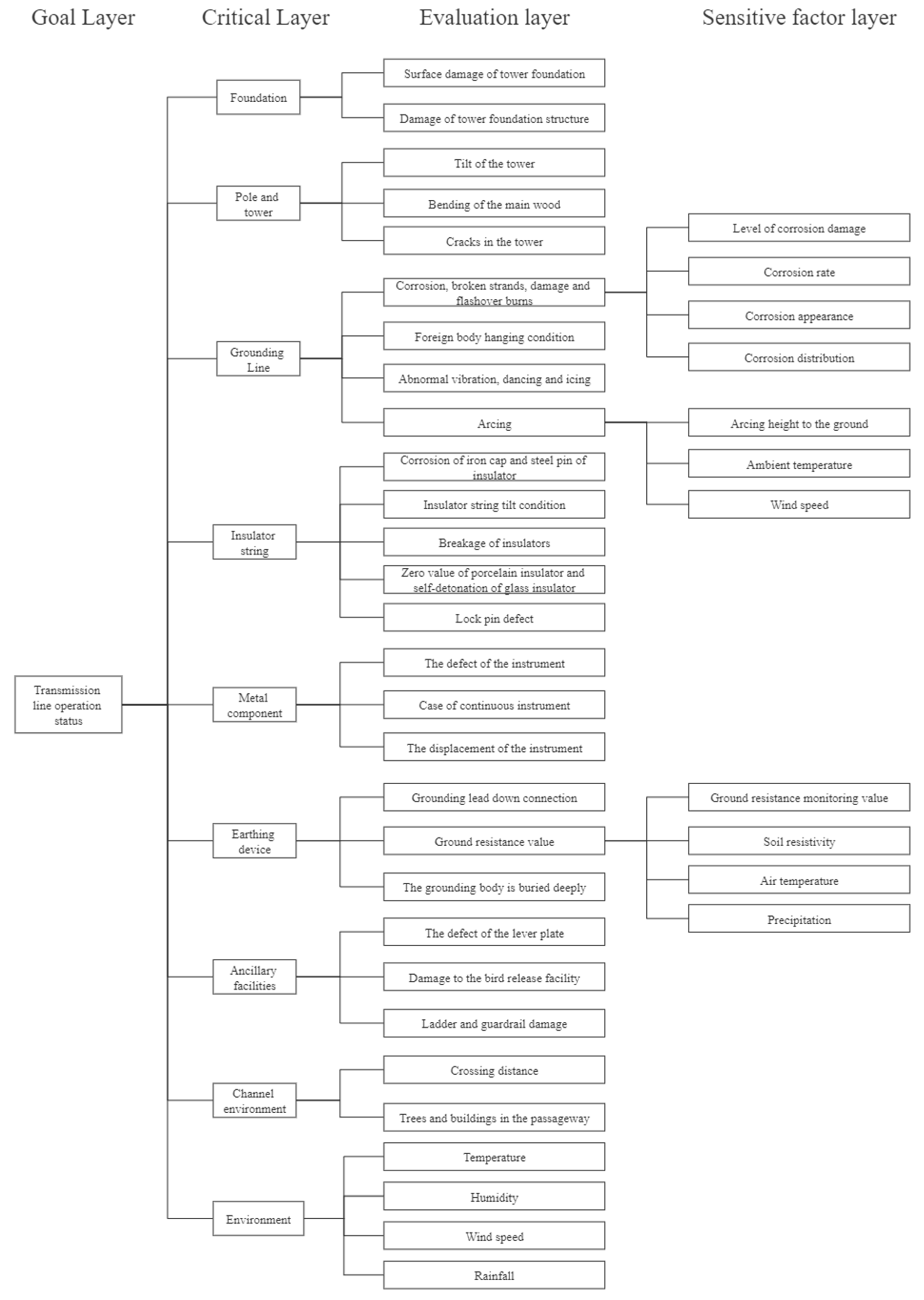
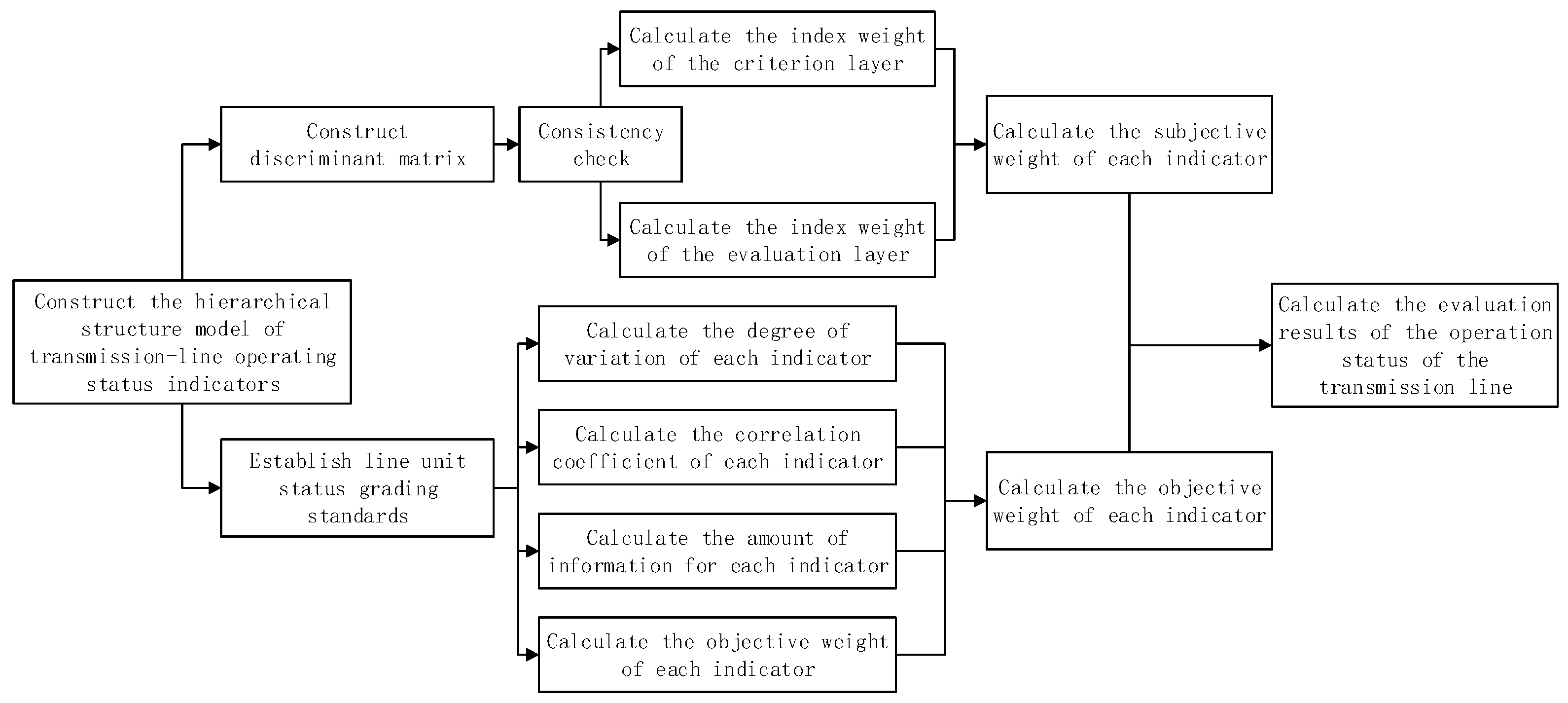


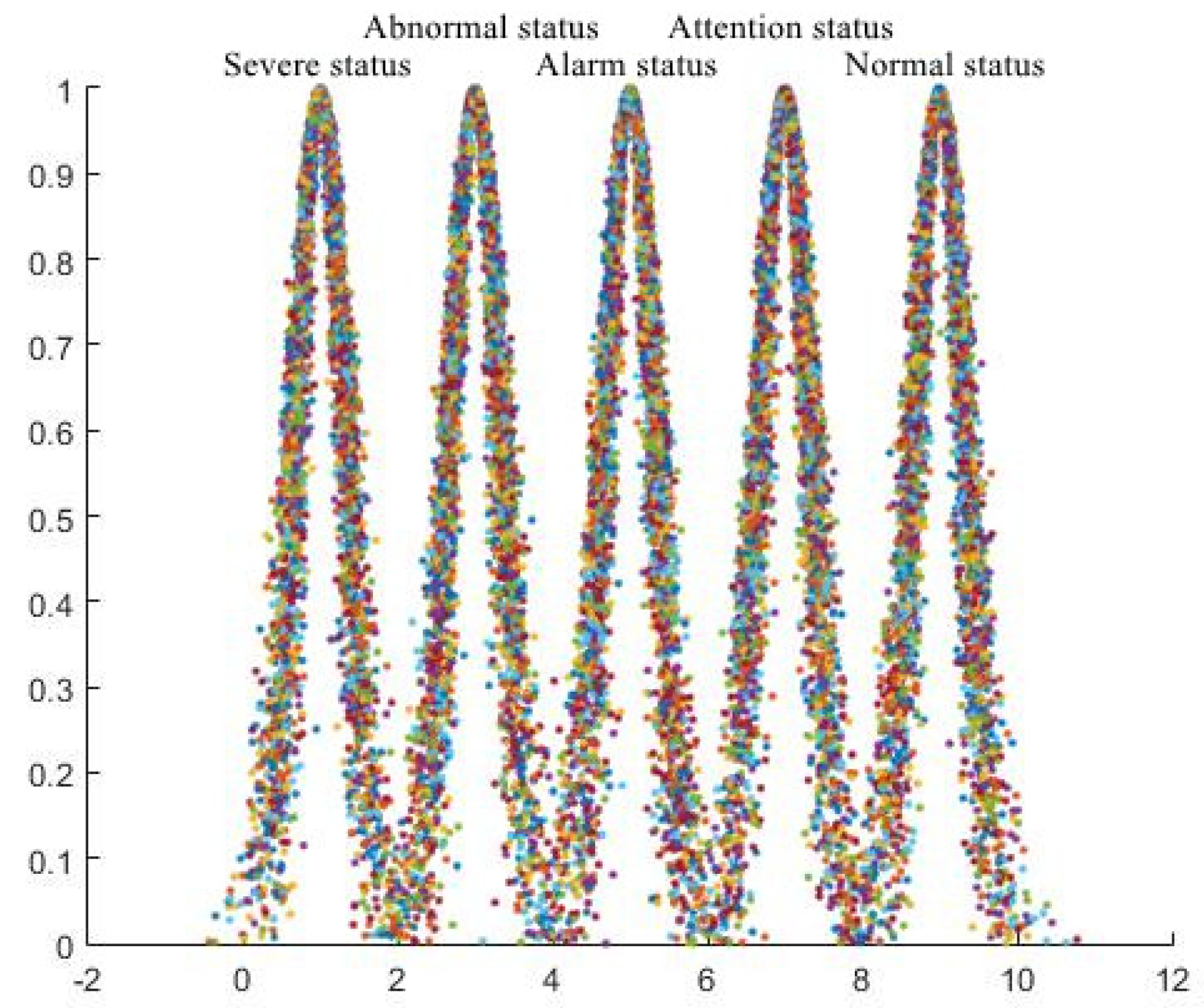


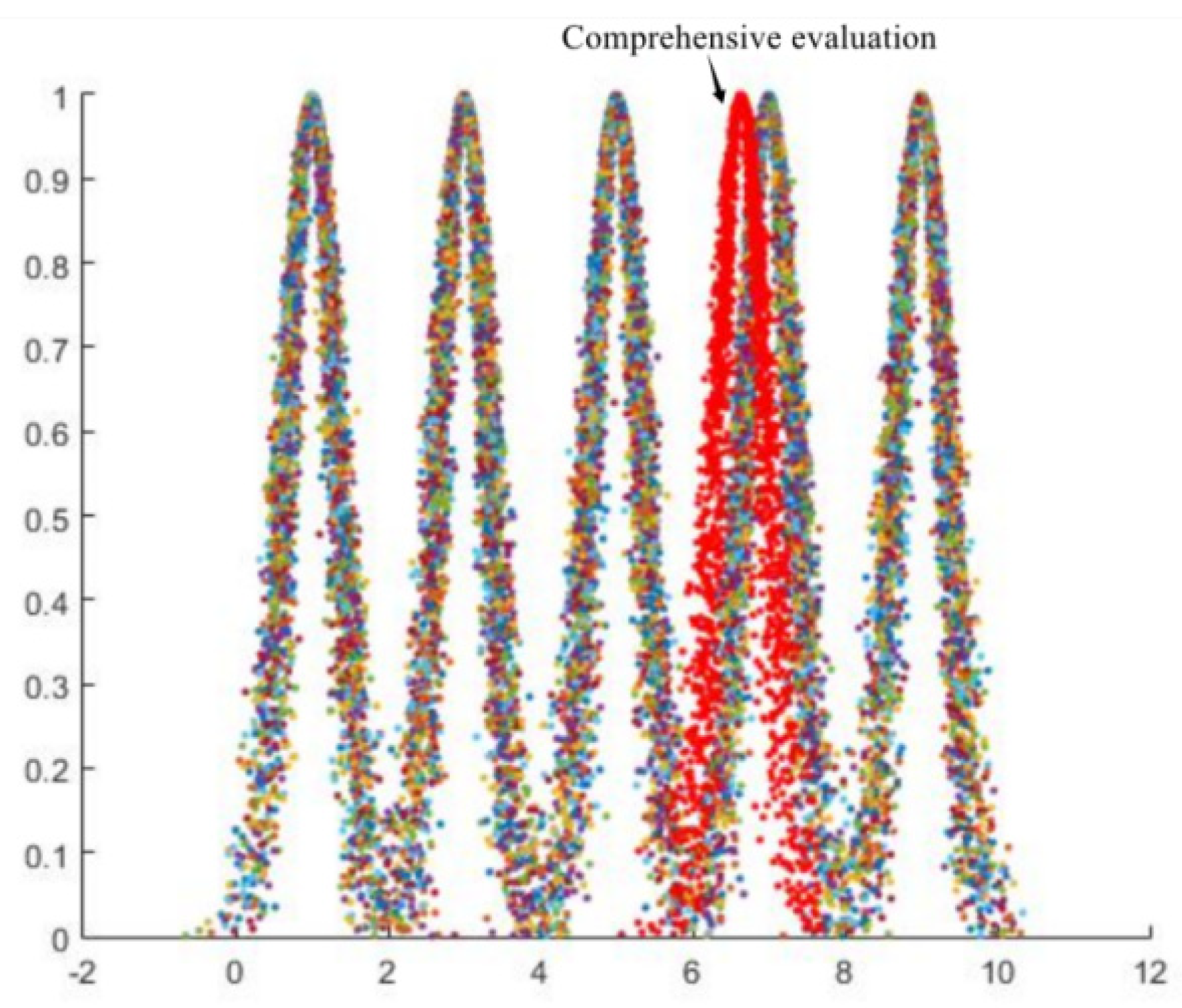

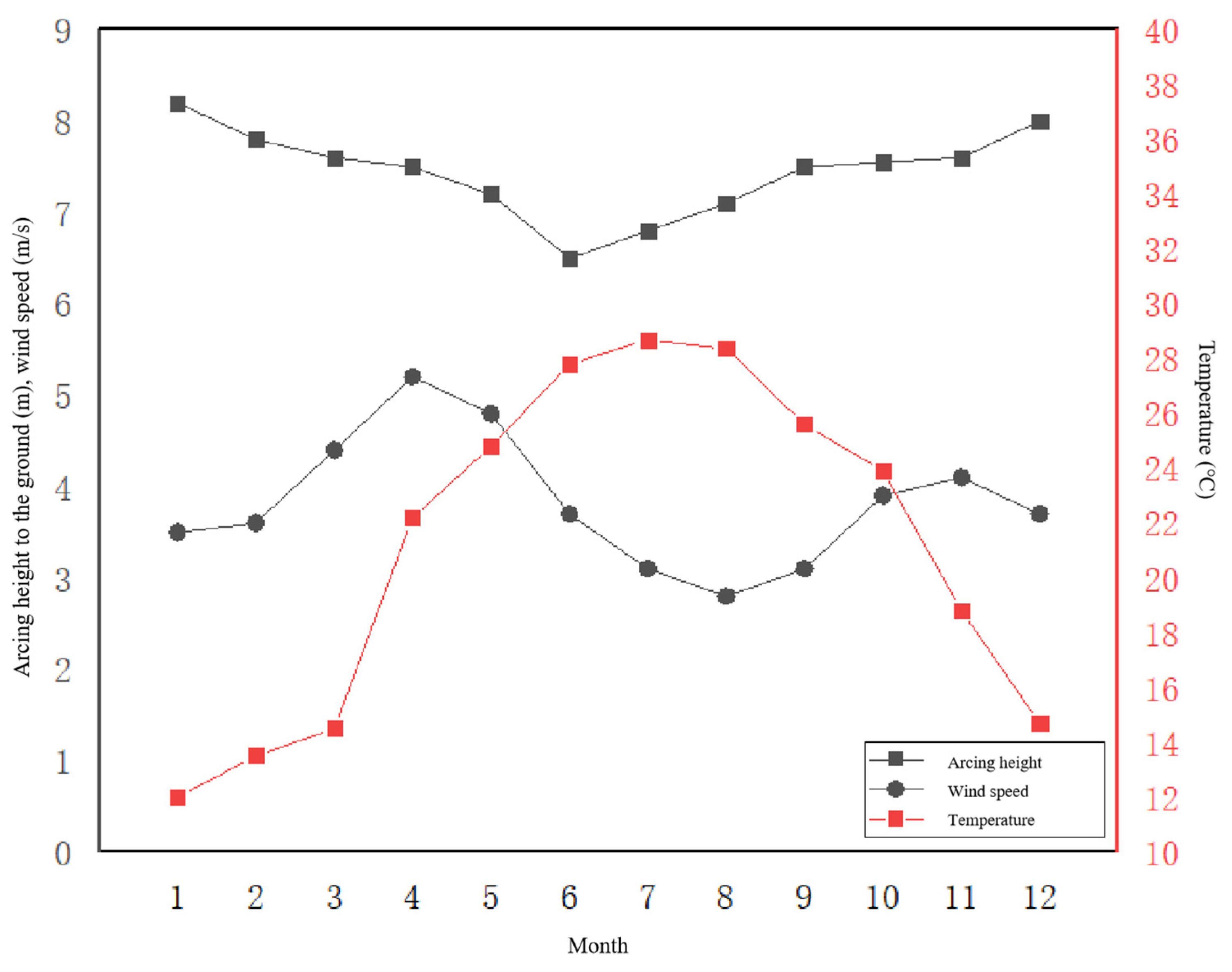

| Importance | Nine-Level Scale Value K | Exponential Scaling Value K-1 (a = 1.316) |
|---|---|---|
| Equally important | 1 | a0 = 1 |
| More than equally important but less than slightly important | 2 | a1 = 1.316 |
| Slightly important | 3 | a2 = 1.732 |
| More than slightly important but less than Important | 4 | a3 = 2.279 |
| Important | 5 | a4 = 3 |
| More than obviously important but less than strongly important | 6 | a5 = 3.947 |
| Strongly important | 7 | a6 = 5.194 |
| More than strongly important but less than extremely important | 8 | a7 = 6.836 |
| Extremely important | 9 | a8 = 9 |
| m | 1 | 2 | 3 | 4 | 5 | 6 | 7 | 8 | 9 | 10 | 11 | 12 |
|---|---|---|---|---|---|---|---|---|---|---|---|---|
| RI | 0 | 0 | 0.52 | 0.89 | 1.12 | 1.26 | 1.36 | 1.41 | 1.46 | 1.49 | 1.52 | 1.54 |
| The Scoring Standard for Line Unit Status [3] | Score |
|---|---|
| Normal status I | 5 |
| General state II | 4 |
| Attention status III | 3 |
| Abnormal state IV | 2 |
| Severe state V | 1 |
| Index | ||||||||
|---|---|---|---|---|---|---|---|---|
| Weights | 0.1078 | 0.3234 | 0.0948 | 0.1867 | 0.1419 | 0.0622 | 0.0473 | 0.0359 |
| Index | ||||||||||||
|---|---|---|---|---|---|---|---|---|---|---|---|---|
| Weights | 0.1378 | 0.1378 | 0.1378 | 0.1378 | 0.1378 | 0.0918 | 0.047 | 0.047 | 0.047 | 0.047 | 0.0157 | 0.0157 |
| Index | ||||||||||||
|---|---|---|---|---|---|---|---|---|---|---|---|---|
| Weights | 0.0196 | 0.0196 | 0.0196 | 0.0196 | 0.0196 | 0.0130 | 0.0067 | 0.0067 | 0.0067 | 0.0067 | 0.0022 | 0.0022 |
| Index | Foundation | Pole and Tower | Guide Ground | Insulator String | Gold Tools | Earthing Device | Ancillary Facilities | Channel Environment | Meteorological Environment |
|---|---|---|---|---|---|---|---|---|---|
| Weights | 0.113 | 0.304 | 0.096 | 0.175 | 0.133 | 0.058 | 0.044 | 0.036 | 0.039 |
| Early Warning Method | Principle | Characteristic |
|---|---|---|
| BP neural network | A self-learning network early warning method continuously updates the data optimisation model through self-learning until it reaches the optimal state [33] | These networks have good adaptability and can handle more complex problems, making them suitable for a wide range of applications [34] |
| Support-vector machine | According to statistical learning theory and the structural risk minimisation principles, limited samples strive to find the best balance between model complexity and learning ability in order to achieve the best generalisation ability [35] | They are particularly useful for solving small, nonlinear problems [36] |
| AHP-fuzzy comprehensive | For the index system, the AHP principle is used to determine the weight by comparing the importance of each index layer by layer, and the overall warning level is obtained by synthesising multiple index values using the membership theory in fuzzy mathematics [37] | Precise results for non-deterministic problems that are difficult to quantify [38] |
| Cloud model | The approach combines experts’ qualitative linguistic value descriptions with scientific quantitative calculation, allowing qualitative information expressed through linguistic values to be transformed into quantitative data or precise numerical values that can be effectively converted into appropriate qualitative linguistic values for analysis [39] | Taking into account randomness and ambiguity to effectively solve complex and fuzzy system problems [40] |
| Early Warning Level | Critical State | Abnormal State | Alert Status | Attention Status | Normal Status |
|---|---|---|---|---|---|
| Scoring interval | [0, c1] | [c1, c2] | [c2, c3] | [c3, c4] | [c4, 10] |
| Early Warning Level | Scoring Interval | Cloud Model Digital Eigenvalues |
|---|---|---|
| Critical state | [0, 2] | (1, 0.33, 0.08) |
| Abnormal state | [2, 4] | (3, 0.33, 0.08) |
| Alert state | [4, 6] | (5, 0.33, 0.08) |
| Attention state | [6, 8] | (7, 0.33, 0.08) |
| Normal state | [8, 10] | (9, 0.33, 0.08) |
| Line | Standard Specification | HSA | Improved HSA | CRITIC | Improved HSA–CRITIC | |||||
|---|---|---|---|---|---|---|---|---|---|---|
| Evaluation Statue | Sort | Evaluation Score | Sort | Evaluation Score | Sort | Evaluation Score | Sort | Evaluation Score | Sort | |
| #1 | Notice | 1 | 4.958 | 1 | 4.930 | 1 | 4.771 | 1 | 4.882 | 1 |
| #2 | Abnormal | 5 | 4.861 | 4 | 4.834 | 4 | 4.120 | 4 | 4.620 | 3 |
| #3 | Notice | 1 | 4.936 | 2 | 4.902 | 2 | 4.615 | 2 | 4.816 | 2 |
| #4 | Notice | 1 | 4.669 | 6 | 4.688 | 6 | 4.233 | 3 | 4.551 | 5 |
| #5 | Notice | 1 | 4.907 | 3 | 4.872 | 3 | 4.021 | 5 | 4.617 | 4 |
| #6 | Serious | 6 | 4.753 | 5 | 4.731 | 5 | 3.798 | 6 | 4.451 | 6 |
| Criterion Layer | Evaluation Layer | Combined Weight Value |
|---|---|---|
| Foundation T1 | Surface damage of tower foundation T11 | 0.040 |
| Foundation settlement T12 | 0.045 | |
| Pole and tower T2 | Tilt of the tower T21 | 0.130 |
| Bending of the main wood T22 | 0.059 | |
| Crack condition of tower rod T23 | 0.066 | |
| Guide ground T3 | Corrosion, broken strands, damage, and flashover burns T31 | 0.035 |
| Foreign body hanging condition T32 | 0.037 | |
| Abnormal vibration, dancing, and icing T33 | 0.012 | |
| Arcing T34 | 0.008 | |
| Insulator string T4 | Corrosion of iron cap and steel pin of insulator T41 | 0.030 |
| Insulator string tilt condition T42 | 0.029 | |
| Breakage of insulators T43 | 0.050 | |
| Zero value of porcelain insulator and self-detonation of glass insulator T44 | 0.038 | |
| Lock pin defect T45 | 0.036 | |
| Gold tools T5 | The defect of the instrument T51 | 0.051 |
| The condition of the fittings T52 | 0.039 | |
| The displacement of the instrument T53 | 0.030 | |
| Earthing device T6 | Grounding lead down connection T61 | 0.032 |
| Ground resistance value T62 | 0.040 | |
| Grounding depth T63 | 0.027 | |
| Ancillary facilities T7 | The defect of the lever plate T71 | 0.032 |
| Damage to bird control facilities T72 | 0.032 | |
| Ladder and guardrail damage T73 | 0.007 | |
| Channel environment T8 | Crossing distance T81 | 0.021 |
| Trees and buildings in the passageway T82 | 0.015 | |
| Meteorological environment T9 | Temperature T91 | 0.031 |
| Humidity T92 | 0.013 | |
| Wind speed T93 | 0.008 | |
| Rainfall T94 | 0.006 |
| Line Name | Inspection Time | Traditional Manual Scoring | Evaluation Score | Precedence Ranking |
|---|---|---|---|---|
| 66 kV Chengbao line | 2021.2 | 4 | 4.176 | 3 |
| 2022.11 | 4 | 4.129 | 4 | |
| 2021.3 | 4 | 4.064 | 5 | |
| 66 kV Chenglan line | 2021.3 | 4 | 4.509 | 1 |
| 2020.6 | 3 | 3.566 | 8 | |
| 2021.3 | 3 | 3.512 | 10 | |
| 66 kV Chengtai line | 2020.4 | 4 | 3.541 | 9 |
| 2022.3 | 4 | 3.759 | 7 | |
| 2022.4 | 4 | 4.333 | 2 | |
| 66 kV Town line | 2022.3 | 4 | 3.892 | 6 |
Disclaimer/Publisher’s Note: The statements, opinions and data contained in all publications are solely those of the individual author(s) and contributor(s) and not of MDPI and/or the editor(s). MDPI and/or the editor(s) disclaim responsibility for any injury to people or property resulting from any ideas, methods, instructions or products referred to in the content. |
© 2023 by the authors. Licensee MDPI, Basel, Switzerland. This article is an open access article distributed under the terms and conditions of the Creative Commons Attribution (CC BY) license (https://creativecommons.org/licenses/by/4.0/).
Share and Cite
Wang, M.; Li, C.; Wang, X.; Piao, Z.; Yang, Y.; Dai, W.; Zhang, Q. Research on Comprehensive Evaluation and Early Warning of Transmission Lines’ Operation Status Based on Dynamic Cloud Computing. Sensors 2023, 23, 1469. https://doi.org/10.3390/s23031469
Wang M, Li C, Wang X, Piao Z, Yang Y, Dai W, Zhang Q. Research on Comprehensive Evaluation and Early Warning of Transmission Lines’ Operation Status Based on Dynamic Cloud Computing. Sensors. 2023; 23(3):1469. https://doi.org/10.3390/s23031469
Chicago/Turabian StyleWang, Minzhen, Cheng Li, Xinheng Wang, Zheyong Piao, Yongsheng Yang, Wentao Dai, and Qi Zhang. 2023. "Research on Comprehensive Evaluation and Early Warning of Transmission Lines’ Operation Status Based on Dynamic Cloud Computing" Sensors 23, no. 3: 1469. https://doi.org/10.3390/s23031469
APA StyleWang, M., Li, C., Wang, X., Piao, Z., Yang, Y., Dai, W., & Zhang, Q. (2023). Research on Comprehensive Evaluation and Early Warning of Transmission Lines’ Operation Status Based on Dynamic Cloud Computing. Sensors, 23(3), 1469. https://doi.org/10.3390/s23031469







